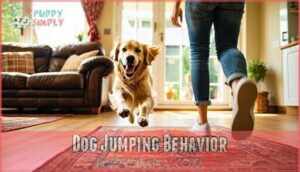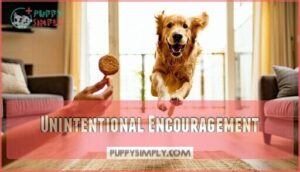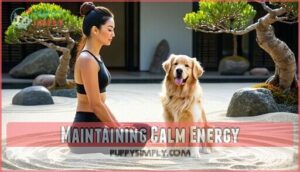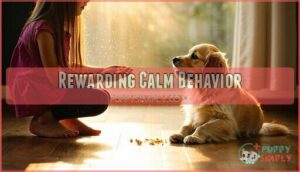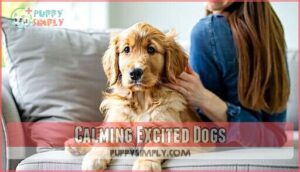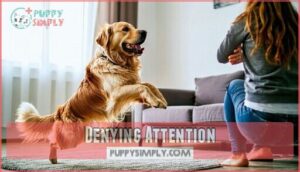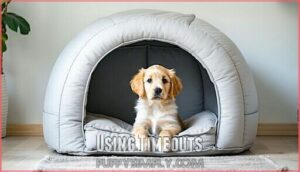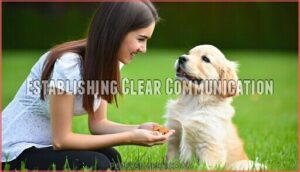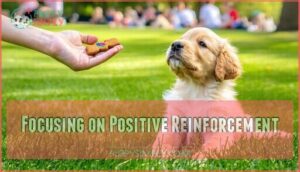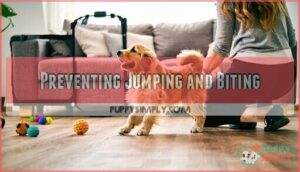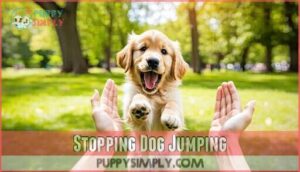This site is supported by our readers. We may earn a commission, at no cost to you, if you purchase through links.
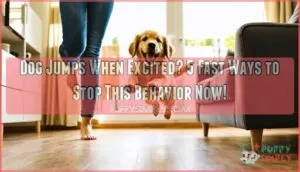 When your dog jumps when excited, they’re trying to get closer to your face—it’s their way of saying "I’m thrilled to see you!" This natural greeting behavior stems from puppyhood but can become problematic.
When your dog jumps when excited, they’re trying to get closer to your face—it’s their way of saying "I’m thrilled to see you!" This natural greeting behavior stems from puppyhood but can become problematic.
You’ll need to ignore the jumping completely—no eye contact, no words, no hands. Turn away until all four paws hit the floor, then calmly reward this better behavior. Consistency is key; everyone in your household must follow the same rules.
Regular exercise also helps burn excess energy that fuels those enthusiastic leaps. The right training approach can transform your bouncy buddy into a polite greeter without dampening their joyful spirit.
Table Of Contents
- Key Takeaways
- Dog Jumping Behavior
- Why Dogs Jump When Excited
- Unintentional Encouragement
- Training Strategies
- Calming Excited Dogs
- Managing Jumping and Biting
- Preventing Jumping and Biting
- Stopping Dog Jumping
- Frequently Asked Questions (FAQs)
- How to stop a dog from jumping on you when excited?
- Why does my dog jump when excited?
- Why does my dog jump a lot during a high arousal moment?
- Why is my dog jumping up?
- What happens if a dog jumps up during a greeting?
- Why does my dog jump and bite when excited?
- How do I stop my dog from jumping when excited?
- Do dogs jump when they are happy?
- Do zoomies mean your dog is happy?
- Should I ignore my dog’s zoomies?
- Conclusion
Key Takeaways
- When your dog jumps during greetings, they’re trying to get closer to your face—it’s their natural way of expressing excitement and seeking attention, not misbehavior.
- You’ll need to completely ignore jumping behavior—no eye contact, no words, no hands—and only reward your dog with attention when all four paws are on the floor.
- Your consistency matters—everyone in your household must follow the same rules, as mixed signals confuse your dog and reinforce the jumping behavior you’re trying to stop.
- Regular exercise helps burn excess energy that fuels jumping, while teaching alternative behaviors like "sit" for greetings gives your dog an appropriate way to channel their excitement.
Dog Jumping Behavior
You’ve probably experienced your pup launching into the air when you grab the leash or when guests arrive, leaving you wondering if you’re raising a dog or a kangaroo.
When your dog jumps on people, they’re not being naughty—they’re simply seeking attention, trying to greet face-to-face, or releasing pent-up excitement in the most direct way they know how.
Investigating Human Objects
Your pooch’s object curiosity often drives them to jump up when you’re carrying things.
They’re trying to investigate what’s in your hands through scent investigation, not just being an excited dog.
This behavior can be concerning, especially around baby safety.
Your dog isn’t necessarily resource guarding; they’re simply using their height advantage to examine what’s interesting to you.
Understanding this dog behavior helps address jumping dog problems effectively.
Retrieving Treats or Toys
Your dog jumps up to retrieve treats or toys from your hands, a classic case of toy motivation driving their excitement.
This behavior happens because dogs learn that jumping gets them what they want.
Here are 5 ways to address this behavior:
- Keep treats at waist level to discourage jumping
- Use hand targeting to redirect focus
- Practice proper reward timing
- Implement treat lure techniques to encourage sitting
- Build impulse control through consistent training
Greeting Strangers Face-to-Face
Your furry friend isn’t being rude when they jump up to greet strangers face-to-face—they’re following their natural social instincts.
Dogs communicate through canine greetings that involve getting close to another’s face.
When your excited dog jumps on visitors, they’re simply trying to establish polite introductions according to dog etiquette.
Understanding this face-to-face communication helps you develop strategies to stop jumping while respecting their greeting needs.
Addressing this behavior can also prevent other dog behaviour problems from developing.
Releasing Excess Energy
After a day of being home alone, your dog jumps because their pent-up energy needs a release valve.
Exercise is essential for managing this behavior, with different breeds requiring various energy outlets. A consistent routine that includes both physical activity and mental stimulation can dramatically reduce jumping.
Try puzzle toys, training sessions, or a quick game of fetch before greeting visitors to help your overexcited pup stay grounded, using mental stimulation to calm them.
Reinforced Through Rewards
Your furry friend’s jumping habit isn’t random—it’s likely reinforced through rewards! Every time you give attention (even negative) when your dog jumps, you’re teaching them this behavior works.
Here’s how rewards create jumping habits:
- Your dog jumps, you react
- Dog associates jumping with attention
- Positive association forms in their brain
- Consistent reinforcement establishes the habit
Proper reward timing is vital for positive reinforcement instead of accidentally encouraging excitement-based jumping.
Why Dogs Jump When Excited
Your dog isn’t jumping on you to be annoying—they’re actually trying to get closer to your face for a proper greeting while releasing their excitement.
When your furry friend can’t contain their joy at seeing you, they’ll use the most direct way they know to get your attention and express their enthusiasm.
Seeking Attention
Your excited jumper is putting on a show—for you! When your dog jumps, they’re usually saying, "Look at me!"
This attention-seeking behavior works because you respond, even negatively. Your pup learns that jumping equals interaction.
Try ignoring jumpers completely—no eye contact, no words, no touch. Instead, reward alternative behaviors like sitting calmly.
Consistent training and calming activities, paired with positive reinforcement, will help your dog find better ways to get your attention.
Greeting Behavior
While attention-seeking explains some jumping, your dog’s greeting behavior stems from natural social dog instincts.
When your pup jumps, they’re trying to reach your face for a proper hello – they’re just mimicking pack behavior used among other dogs.
This face-to-face greeting ritual originates from canine communication patterns, and understanding this helps you redirect these polite canine welcomes into more human-friendly greetings through calmness and positive reinforcement.
Excitement and Overstimulation
Beyond just saying hello, your dog’s jumping often stems from overwhelming excitement and overstimulation.
When threshold levels are exceeded, your pup lacks impulse control and literally can’t contain their energy release.
Environmental triggers like doorbells or visitors can send them over the edge.
Some breed tendencies make certain dogs more prone to overexcitement.
Think of it as your dog’s arousal system going into overdrive—they’re literally bursting with uncontrollable dog stimulation.
Anxiety or Conflict
Sometimes your furry friend jumps not from joy, but from anxiety or conflict.
When dogs feel fearful or uncertain, jumping can be their way of managing stress.
Watch for other stress signals like pinned ears or a tucked tail.
By identifying these triggers, you’ll better understand if your dog’s jumping stems from fear rather than excitement.
Calming techniques and dog behavior modification can help address this defensiveness.
Unintentional Encouragement
You’re probably reinforcing your dog’s jumping without even realizing it, as even negative attention like pushing them away can be rewarding to an excitement-seeking pup.
Your reaction, whether it’s laughing, petting, or scolding, tells your dog that jumping works to get your attention, making this problematic behavior harder to break.
Providing Attention
When your dog jumps excitedly, your reaction—even if negative—acts as a reward that reinforces this unwanted behavior.
Dogs interpret any attention as positive reinforcement, turning your pushes and "no’s" into accidental training sessions for more jumping.
- Withholding attention completely sends a clear message that jumping won’t get them what they want
- Turning your back immediately shows your excited dog that calm behavior earns interaction
- Consistent reactions from everyone in the household are essential for breaking the attention-seeking cycle
Inconsistent Corrections
Many dog owners create a training nightmare through inconsistent corrections.
When you scold your pup one day for jumping but laugh it off the next, you’re sending mixed signals that confuse your furry friend.
These conflicting cues and unclear expectations make it impossible for dogs to understand what’s acceptable.
Variable enforcement or delayed responses to jumping behavior only reinforce the problem, making positive reinforcement techniques less effective.
Consistency is key to redirecting behavior successfully.
Unmet Exercise Needs
Your pup’s boundless energy needs a proper outlet.
If you’re not providing adequate exercise frequency for your dog’s breed specifics and energy levels, that excitement has to go somewhere.
Fetch, long sniffy walks, and nose work games offer both physical exercise and mental stimulation.
Addressing your dog’s jumping may require you to think about their species specific behaviors.
When Fido’s energy tank is properly emptied, he’ll be less likely to use you as a springboard during greetings, which is why proper outlet and exercise frequency are crucial, and understanding species specific behaviors can help, and providing mental stimulation is key.
Negative Attention
Yelling at your excited pup might seem like the right move, but negative attention actually fuels their jumping behavior.
When you push or scold your furry friend, you’re unintentionally rewarding their attention-seeking tactics.
- Pushing consequences include increased arousal and more persistent jumping
- Habitual greetings become reinforced when any reaction is given
- Misinterpreted aggression can develop from what started as simple excitement
Your dog can’t tell the difference—attention is attention!
Training Strategies
You’ll need both consistency and patience to transform your excitable jumper into a well-mannered companion.
With the right training approach, you can channel your dog’s enthusiasm into more appropriate greetings that won’t leave visitors covered in paw prints.
Maintaining Calm Energy
Your dog mirrors whatever vibe you’re putting out there.
When you stay calm during their excitement, you’re teaching them through energy transfer that calmness wins.
Your body language and emotional regulation become their roadmap.
Consistent demeanor beats yelling every time.
Think of yourself as their zen master – your owner’s mindset directly shapes their response to situations, where emotional regulation is key.
Ignoring Jumping Behavior
Silence becomes your most powerful tool when dealing with attention-seeking dog jumping behavior. Your pup craves interaction, so removing yourself eliminates their reward system entirely.
- Turn your back immediately when jumping starts, crossing arms and avoiding eye contact
- Walk away calmly if the dog circles around to continue jumping
- Wait for four paws down before acknowledging your dog’s presence
- Repeat consistently until ignoring challenges disappear and long-term success emerges
The steps outlined are designed to help you address the issue effectively, by removing the attention the dog seeks when jumping, thus eliminating the behavior over time.
Rewarding Calm Behavior
Timing-based rewards work like magic when your dog keeps all four paws planted.
The moment you see calm dog behavior, offer treats and consistent praise immediately, creating positive reinforcement that shapes calmness through rewarding good behavior.
Many owners find treats aid relaxation during training, which is a crucial aspect of making dog training rewards meaningful.
Remember, treat timing beats ignoring escalation every time, as it creates clear boundaries around dog excitement.
Educating Visitors
Most guests unknowingly fuel dog jumping by giving attention during excited greetings. You’ll need to coach visitors on proper greeting protocols before they enter your home.
Share these visitor instructions to guarantee consistent reinforcement and manage excitement safely around strangers.
- Ignore jumping completely – no eye contact, touching, or verbal responses until all paws hit the ground
- Turn away when your dog jumps, keeping backs turned until they naturally sit down
- Reward calm behavior with gentle praise only after excitement settles and proper greeting occurs
Remember that dogs often jump because of attention-seeking jumps at attention-seeking jumps. This behavior can be managed by following the provided instructions and rewarding good behavior. By doing so, you can prevent undesirable actions and promote a safe environment for both your dog and visitors.
Calming Excited Dogs
You’ll find that calming your excited dog is much like helping a toddler settle down after too much sugar – it requires patience and a consistent approach.
Your energy directly influences your dog’s behavior, so maintaining a calm presence will help your furry friend learn to control their jumping impulses when excitement takes over.
Projecting Calm Presence
Now that you’ve got some training strategies in mind, your own demeanor makes all the difference.
Dogs are emotional sponges – they absorb your energy.
When your pup gets jumpy, take a deep breath and project calm energy through your body language.
Stand tall with relaxed shoulders, avoid quick movements, and maintain a consistent demeanor.
This structured environment helps your dog understand that excitement doesn’t earn attention – quiet interactions do.
Avoiding High-Pitched Tones
Your calm presence sets the stage, but your voice completes the picture.
High-pitched tones can push your dog over their excitement threshold, triggering jumping behavior.
When interacting with your excited pup:
- Keep your voice low and steady, almost monotone
- Speak slowly, as if you’re half-asleep
- Avoid baby talk or squeaky "good boy!" phrases
- Maintain consistent vocal control, even when you’re happy to see them
Your calm communication directly impacts your dog’s jumping behavior, and it’s essential to maintain consistent vocal control.
Using a low and steady tone can help prevent your dog from getting overexcited.
Practicing Basic Commands
During moments of excitement, practicing basic commands like "sit," "stay," and "down" creates a foundation for your dog’s self-control.
Start in distraction-free environments, gradually introducing mild excitement triggers.
Use your leash for added control during these exercises. Recall training is particularly effective—it teaches your dog to come to you rather than jump.
Consistent dog obedience work transforms excited energy into focused attention through positive reinforcement.
Rewarding Obedience
Once your dog responds to basic commands, reward that obedience immediately.
Timing is everything with positive reinforcement—your pup needs to connect the good behavior with the treat or praise.
- Give rewards within 1-2 seconds of the desired behavior
- Use high-value treats for difficult situations or distractions
- Mix up rewards between treats, toys, and verbal praise
Consistent rewards will help your dog associate staying calm with good things, making training stick faster than a treat to a peanut butter spoon.
Addressing overexcitement requires consistent training techniques, and it’s crucial to use consistent training for effective results, leading to a more calm dog.
Managing Jumping and Biting
When your excited pup turns into a jumping, nipping tornado, you’ll need to set clear boundaries while redirecting that enthusiasm to appropriate outlets.
You can effectively manage these behaviors by consistently denying attention when they jump and focusing on rewarding calm greetings instead.
Denying Attention
Now that you know how to project a calm presence, let’s look at your most powerful tool: simply denying attention.
When your excited dog jumps, turn away immediately and cross your arms. This sends a clear message that attention-seeking through jumping gets zero rewards.
Remove yourself from the room if needed. Consistency is key—every family member must ignore jumping behavior completely, even during calm departures.
Your pup will quickly learn jumping leads nowhere, and this approach will help you achieve a calm environment, where zero rewards are given for unwanted behavior.
Using Timeouts
When denying attention isn’t enough, timeouts can be your secret weapon for controlling jumping. Implementing brief separation gives your furry friend a chance to reset their excitement levels.
- Timeout Duration: Keep timeouts short (30-60 seconds) to maintain effectiveness
- Timeout Location: Use a quiet, boring area away from action
- Consistency Matters: Apply timeouts immediately after jumping occurs
- Timeout Alternatives: Try a leash tether for older dogs
- Puppy Timeouts: Be extra gentle with young dogs still learning boundaries
Your dog’s excessive jumping needs clear consequences that aren’t fun but aren’t harsh either. Dog excitement management improves dramatically when they learn that jumping equals boring alone time! Timeouts can be an effective tool, and it’s essential to apply them immediately after the undesired behavior occurs, ensuring consistency in training.
Establishing Clear Communication
After timeouts, your next step is establishing clear communication with your furry friend.
Consistent signals are key – your dog can’t read your mind! Use the same commands every time and pair them with matching body language.
Tone matters too – keep it firm but kind. Command clarity helps build mutual understanding between you two.
When your pup knows exactly what you expect, jumping behavior becomes much easier to control, leading to better mutual understanding.
Focusing on Positive Reinforcement
Catching your dog doing the right thing is the foundation of positive reinforcement. When your furry friend keeps all four paws on the ground, immediately reward this calmness with treats and consistent praise.
This shaping behavior approach helps your dog connect staying down with good things happening. For stop jumping success, use treat training during positive greetings, making calm behavior more rewarding than the excitement of jumping up.
Preventing Jumping and Biting
You’ll save your fingers and furniture by taking a few simple steps to prevent your excited pup from turning into a furry tornado of jumps and nips.
Setting clear boundaries early, like engaging in calming activities before guests arrive and having plenty of appropriate chew toys on hand, will help your dog learn better ways to channel that tail-wagging enthusiasm.
Engaging in Calming Activities
Beyond stopping unwanted behaviors, you’ll need to help your excited pup find their inner zen.
Calming activities work wonders before situations that typically trigger jumping.
- Give your dog a gentle 5-minute massage to release tension
- Try aromatherapy with lavender scents for a calming effect
- Provide puzzle toys for mental stimulation that tires them out
- Practice short meditation-style breathing exercises together
- Create a relaxing environment with soft music or white noise
These dog training techniques reduce overstimulation and promote dog calmness naturally.
Avoiding Overstimulating Play
While calming activities help your dog relax, you’ll also need to monitor playtime closely. Overstimulating play is often the hidden culprit behind jumping behaviors.
When you engage with your high-energy pup, consider these play alternatives:
| Play Type | Effect on Behavior | Better Alternatives |
|---|---|---|
| Rough wrestling | Encourages jumping/nipping | Gentle tug with rules |
| Chase games | Increases overexcitement | Structured fetch |
| Frantic play | Builds dog overstimulation | Calm hide-and-seek |
| Extended high-energy sessions | Reduces impulse control | Short, focused training games |
Creating a controlled environment for play teaches your dog when excitement is appropriate, helping to reduce overstimulation and promote impulse control through structured activities.
Providing Appropriate Chew Toys
While limiting excitable play helps, giving your dog something appropriate to chomp on is equally important for managing that jumpy energy. Chew toys aren’t just pacifiers—they’re mental stimulation tools that redirect your pup’s excitement.
Choose the right chew toys by following these guidelines:
- Match the toy size to your dog’s mouth to prevent choking hazards
- Select materials softer than your dog’s teeth to protect dental health
- Consider your dog’s play style (chewer, cuddler, or chaser)
- Rotate toys regularly to maintain interest and engagement
Durable chew toys give your overexcited jumper something constructive to focus on, helping them learn self-control when overwhelmed by enthusiasm. Consider browsing a site for various dog products to find the best fit.
Redirecting With Toys
When your dog starts jumping with excitement, quickly grab their favorite toy as your secret weapon.
Redirect their energy by engaging them with the toy instead of allowing the jumping behavior to continue.
Teaching bite inhibition can also help curb unwanted behaviors.
| Toy Type | Benefits | Best For |
|---|---|---|
| Tug toys | Builds impulse control | High-energy breeds |
| Puzzle toys | Mental stimulation | Smart, focused dogs |
| Squeaky toys | Immediate attention grabber | Easily distracted jumpers |
Remember, consistent redirection teaches your pup that calm behavior earns playtime, and using their favorite toy can be an effective way to achieve this, by providing mental stimulation.
Stopping Dog Jumping
You can stop your dog’s excited jumping with a few simple, consistent techniques that send a clear message about acceptable greeting behavior.
When you ignore the jumping completely and reward your pup only when all four paws are on the ground, you’ll be amazed at how quickly they learn that calm greetings earn your attention.
Completely Ignoring Dog
When your furry friend starts jumping for joy, turn into a statue.
Complete silence and zero eye contact are your best weapons here. It sounds simple, but consistency is the key to success with this ignoring technique.
Most dogs are attention-seeking by nature, so removing all interaction teaches them that jumping gets them nowhere. Remember, even frustrated owners must stick with it!
Positive reinforcement, such as rewarding calm behavior, is also key when teaching dogs to reduce jumping, and it helps to achieve calm behavior through this method, ensuring success with the technique.
Immediately Getting Out of Reach
When your excited pup launches into the air, swift action is key.
Step back quickly to deny attention and avoid reinforcement of jumping behavior.
Don’t run away, as this may prevent chasing instincts from kicking in.
For puppies learning impulse control, calmly move out of reach without making eye contact.
This technique, paired with a calm departure when needed, consistently shows dogs that jumping gets them nowhere.
Teaching Alternative Behaviors
A smart approach to stopping your jumpy pup is teaching alternative behaviors.
Instead of just saying "no," use a target command to redirect attention elsewhere.
Try "touch" (nose to palm) or "place" (go to bed) as positive interrupters when excitement builds.
These dog training techniques develop impulse control naturally.
High-value rewards like motivational training treats can reinforce these behaviors.
Reward calmness consistently, and you’ll be shaping calmness while giving your dog something constructive to do instead of jumping.
Practicing Consistent Training
In the context of stopping jumping behavior, practicing consistent training is your golden ticket to success.
Consistency builds impulse control and helps your dog understand expectations clearly.
For effective command generalization and environmental proofing:
- Practice in different locations with varying distractions
- Maintain handler consistency among all family members
- Keep training duration short but frequent for better reinforcement schedules
Remember, dog training isn’t a one-time event—it’s a daily conversation between you and your four-legged friend.
Frequently Asked Questions (FAQs)
How to stop a dog from jumping on you when excited?
Like a whirlwind of fur and joy, your dog needs clear boundaries.
Turn away when they jump, reward all four paws on the ground, and stay consistent.
You’ll train them with patience and time.
Why does my dog jump when excited?
Your dog jumps when excited because it’s seeking attention, trying to greet you face-to-face, or releasing excess energy.
Dogs naturally want to engage at eye level, and they’ve learned that jumping gets a reaction from you.
Why does my dog jump a lot during a high arousal moment?
Nearly 80% of dog owners report excessive jumping during high-arousal moments.
Your dog’s jumping is a natural response to overstimulation, releasing pent-up energy and seeking attention or interaction when they’re unable to contain their excitement.
Why is my dog jumping up?
Your dog’s jumping up is likely their way of seeking attention, expressing excitement, or trying to greet you face-to-face.
Dogs often jump when they’re happy to see you or feel overstimulated.
What happens if a dog jumps up during a greeting?
When your dog jumps during greetings, you’re reinforcing the behavior with attention.
This can lead to scratches, knocked-over guests, or frightened visitors.
Turn away calmly until all paws return to the ground, this action will help to stop the behavior.
Why does my dog jump and bite when excited?
Your dog’s airborne antics represent bottled-up energy seeking release.
They’re expressing excitement through physical outlets, trying to engage with you face-to-face.
This behavior is often learned when it gets attention, even negative reactions, and can be considered an attempt to initiate interaction, driven by excitement.
How do I stop my dog from jumping when excited?
To stop excited jumping, ignore your dog completely when it happens.
Turn away, cross your arms, and wait for calm behavior.
Reward with attention only when all four paws are on the ground, this is the moment to acknowledge calm behavior.
Do dogs jump when they are happy?
Yes, your dog’s jumping often signals happiness and excitement.
They’re simply expressing joy and trying to greet you face-to-face.
It’s their natural way of showing enthusiasm when they’re feeling particularly happy.
Do zoomies mean your dog is happy?
Like fireworks bursting with energy, zoomies typically signal your dog’s happiness and joy. They’re a natural way your pup releases excitement, celebrates feeling good, or expresses relief after being confined.
Should I ignore my dog’s zoomies?
Zoomies are generally harmless, so you don’t need to stop them.
Let your dog enjoy this natural energy release in a safe space, but redirect if they’re getting too wild or destructive.
Conclusion
Surprisingly, the moment your dog jumps when excited often coincides with your own heightened emotions.
Remember, consistency transforms jumping habits into proper greetings. By ignoring jumps, rewarding calm behavior, and ensuring everyone follows the same rules, you’ll see impressive results within weeks.
Regular exercise depletes that excess energy before it becomes problematic. With patience and these proven techniques, your enthusiastic companion will soon greet you and guests with all four paws respectfully on the ground, demonstrating proper greetings.
- https://www.rover.com/blog/why-do-dogs-jump-on-you/
- https://vcahospitals.com/know-your-pet/dog-behavior-problems-greeting-behavior-jumping-up
- https://www.thesprucepets.com/how-to-stop-jumping-in-dogs-1117873
- https://zoomroom.com/admin/stop-dog-jumping/
- https://www.pawleaks.com/keep-dog-entertained-in-yard/

